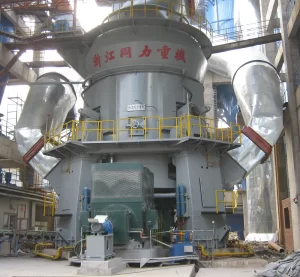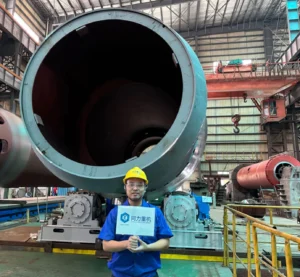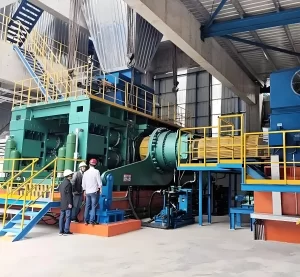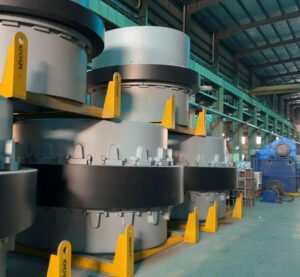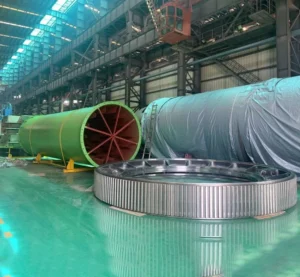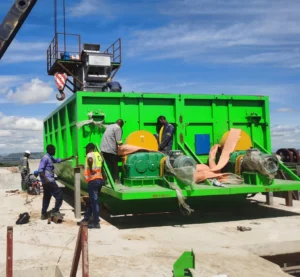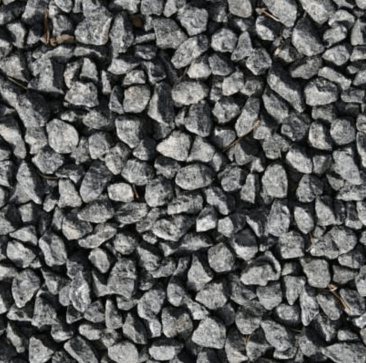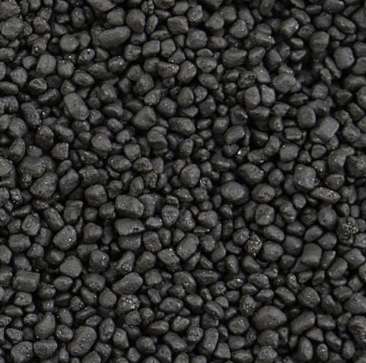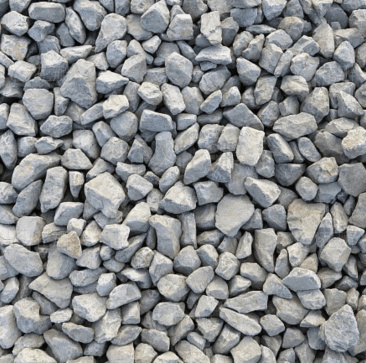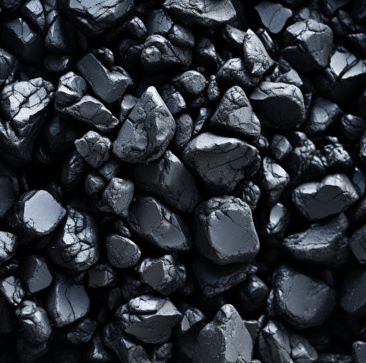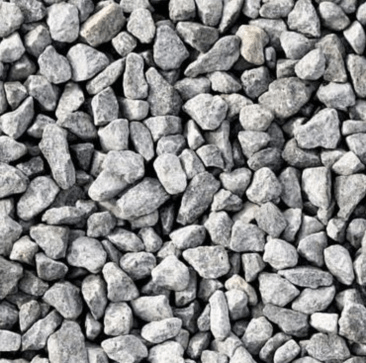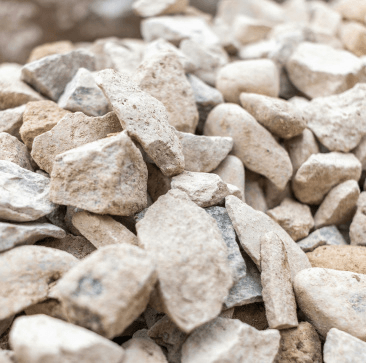-
5 Cement Grinding ball mill lining design features you should known
Our ball mill shell liners aren’t just standard parts , they’re built to match your job. In our two-compartment cement ball mills, the first chamber handles the rough stuff. It’s fitted with step liners made for big grinding media, tough enough to chew through coarse clinker. We usually go with medium-carbon, medium-chromium alloy steel, rocking a hardness of HRC48~55 and an impact toughness around ak15~20 J/cm² , good for a solid 2~3 years of service. Step it up to high-chromium cast iron, and you’re looking at 4~6 years easy.
For the real heavy hitters, mills with a 3 m diameter or more, we use high-toughness, high-chromium cast iron liners. These beasts come in at HRC58~62 hardness, ak8~12 J/cm² toughness, and can last 6~10 years. They guard the shell like armor while giving just the right lift to keep the grinding charge moving efficiently.
Now, the second chamber, that’s where the finesse happens. This fine grinding zone gets a corrugated liner to squeeze out max power draw and grinding efficiency. We use wear-resistant, high-hardness materials here too, like high-carbon alloy steel (HRC > 50, ak4~6 J/cm²). For special setups, we can throw in classifying liners to fine-tune performance.
Every inch of the mill is protected by bolted-on liners designed for the exact wear patterns each area faces. When a liner’s done its job and worn out, you just unbolt and swap, no drama, no downtime. It’s all about keeping your mill running smoother, longer, and stronger.
Now Structure wise our ball mill liner has the following features: In the first chamber, the liner adopts a high-impact “dynamic energy” structure designed for coarse grinding of large particles, usually 10–30 mm. This chamber depends on the strong falling impact of large grinding balls, so the liner is shaped with high waves or raised ribs, typically 15–30 mm high and spaced 50–80 mm apart. The rough surface increases friction to lift the balls higher, prevents sliding, and forms a blocking effect that keeps material longer for better crushing. The wave or rib design also cushions the shell against heavy impacts, especially in large mills. For large-diameter mills, step liners are used, arranged in a spiral stair pattern with 5–10 mm height differences, guiding material movement along the axis and cutting large clinker pieces for higher grinding efficiency. The first-chamber liners are 25–40 mm thick, secured with 16–24 mm high-strength bolts, and sometimes strengthened with ribs to handle the 3–5 times higher impact load compared with the second chamber.
In the second chamber, the liner follows a “close-contact” structure optimized for fine grinding of smaller particles, about 1–5 mm. The surface is made with low waves or a smooth flat shape, 5–15 mm high and 30–50 mm apart, reducing the ball grip and encouraging a cascading motion rather than impact. This improves contact frequency between balls and material, increases the grinding time, and works well with small grinding media such as 20–40 mm steel cylinders. For higher fineness requirements, grooved liners with 8–12 mm wide and 3–5 mm deep channels are used; the grooves hold a layer of material for inter-particle grinding and prevent ball slipping or idle rotation, especially with sticky feed. The second-chamber liners are thinner, 15–30 mm thick, smaller in size (about 300×200 mm), and installed tightly with gaps below 2 mm to save space for media and avoid material clogging or uneven wear.
-
What are the parts components of a cement grinding ball mill?
1. The ball mill body: The ball mill shell is made of all-welded steel construction, the cylindrical cement grinding mill shells, fabricated from premium rolled steel plates, feature specific dimensions and material specifications tailored to cement ball mill operation. On each side of the ball and mill, there’s a T-sectional welded-up slide ring and four manholes, two for each grinding compartment. A ball mill for cement grinding φ3.5×13 m uses a shell made of Q235-B rolled steel, with a plate thickness of 38 mm to withstand high operational stresses. We also conduct NDT non-destructive testing like ultrasonic/magnetic examination to confirm airtightness of the grinding ball mill shell. This ensures that your cement mill or cement finish mill runs reliably under all conditions.
2.The slide shoe bearing: The design only needs simpler foundations and has a lower installation height, reducing civil construction costs. The base plates are easy to align, saving both time and labor during installation. The slide shoes and bearing casing can be installed separately, making assembly and maintenance simple. The closed bearing housing prevents oil leakage, keeping the system clean and reducing maintenance work. The slide shoes are easy to replace when needed, which shortens downtime and improves operation efficiency of the ball grinder. Since there are no rollers, there is no risk of the moveable bearing getting blocked, ensuring smooth and reliable ball mill cement operation. Each slide ring is supported by two self-aligning, hydrodynamically lubricated, and water-cooled slide shoes that ensure smooth rotation and stable load distribution. The slide shoe at the drive end holds the mill cement in the axial direction, while the others allow free axial movement to accommodate thermal expansion and contraction of the ball grinding mill body. The bearings operate on a continuous film of lubricating oil to prevent metal-to-metal contact, reducing wear, friction, and noise. Each bearing assembly is connected to a fully enclosed lubrication and conditioning unit equipped with an oil tank, motorized low- and high-pressure pumps, filtration, and a temperature-controlled heating and cooling system, ensuring reliable lubrication, stable oil temperature, and consistent performance for the ball mill for cement grinding under all operating conditions.
3.Inlet & Outlet System: At the inlet, a strong steel duct introduces venting air evenly into the cement ball mill to maintain proper internal pressure and cooling. The airflow is controlled by a manually (automatic also available) adjustable throttle valve and monitored through a pressure gauge, allowing operators to fine-tune the air volume and prevent dust leakage or backflow. The feed chute, made from ASTM A36/ DIN 17100/ ISO 630, is lined with thick, bolted wear-resistant plates to handle abrasive materials such as clinker, slag, or raw mix for the ball mill for grinding. Its slope is optimized between 25°–30° to ensure a continuous feed while reducing material buildup. At the discharge end, the outlet casing is constructed to withstand high temperatures and negative pressure inside the cement grinding mill. The casing is fully insulated with layers of high-temperature mineral wool, which helps minimize heat loss and protect the outer structure from thermal expansion. Between the stationary outlet casing and the rotating outlet cone, flexible and heat-resistant seals are installed to prevent dust escape and maintain an airtight system during rotation of the grinding mill cement.
4.PLC Control system: What is a ball mill? Our PLC Control Monitoring system continuously monitors key operating parameters such as material and air temperatures, internal pressure, and mill load level inside the ball mill for cement grinding. Airflow and pressure are regulated by a damper at the mill fan inlet to maintain proper ventilation and prevent dust leakage. The material filling level is detected by acoustic/electronic sensors to ensure steady grinding conditions in the cement mill. In closed-circuit systems, the circulating load is measured by weighing the separator reject stream, allowing precise control of product fineness for the ball grinder or concrete mill. These automatic monitoring and adjustment functions ensure consistent ball mill cement efficiency, energy savings, and reliable operation of the ball and mill.5.
-
How Our Ball Mill Diaphragm Matrix C Design Improves Cement Grinding Efficiency?
Tongli’s advanced Matrix C ball mill diaphragm designachieves superior grinding efficiency and consistent cement quality. Positioned between the coarse and fine grinding chambers, the diaphragm not only controls material flow but also optimizes energy distribution within the mill. Engineered with precision using wear-resistant alloy steel and state-of-the-art structural design, Tongli diaphragms ensure long service life, reduced maintenance, and higher throughput compared to conventional systems.
1. Material flow & particle size control: Tongli’s diaphragm system has intelligent material flow management. Our diaphragms are designed to retain coarse particles in the first chamber until they are properly crushed to the target size before passing into the second chamber. This ensures efficient use of grinding energy, stabilizes material classification, and maintains uniform product fineness. By preventing oversize clinker from entering the fine grinding zone, the overall mill efficiency can improve by 4–6%, while reducing specific power consumption by up to 5 kWh per ton of cement.
2. Increased effective grinding area (length used well): Second benefit is the maximization of the effective grinding area. Tongli’s Matrix C diaphragm features a short built-in length and an optimized grate structure that increases the active grinding volume inside the mill. This translates directly into higher throughput — field data from Tongli installations show capacity improvements of 3–8% compared with standard diaphragm configurations. The carefully calculated slot geometry ensures smooth, unrestricted material flow, even under heavy load or variable feed conditions, minimizing dead zones and enhancing overall mill utilization.
3. Adjustable lifters & material level control: Tongli Matrix C diaphragm is equipped with adjustable lifters that allow precise control of material levels in both chambers. Proper compartment filling is critical to efficient grinding: too little material reduces impact energy, while too much reduces ventilation and grinding action. The adjustable lifters help operators fine-tune the mill’s internal dynamics, maintaining optimal load balance and steady mill pressure. This control not only enhances grinding stability but also extends liner and media life, lowering operational costs over the long term.
4. Free flow area, slot/grate design: Matrix C diaphragm’s slot and grate design also contribute significantly to performance. It adopts large free-flow areas combined with conical slot openings that promote high circulation rates and eliminate material build-up. This geometry keeps pressure drop across the diaphragm low, ensuring efficient airflow through the mill. Lower pressure means less energy wasted in material movement and improved cooling of the grinding media — a crucial factor when operating under high temperatures or with moist feed materials.
5. Material & durability: Durability and ease of maintenance are core design principles in every Matrix C diaphragm. We use heat-treated, high-chromium alloy steel for critical wear areas, achieving hardness values up to HRC 58–62. The modular, bolted construction allows worn segments to be replaced individually without dismantling the entire diaphragm, reducing downtime and maintenance costs. In typical cement grinding operations, the service life of Tongli’s diaphragm grates exceeds 18,000 hours, with the fine grinding facing plates reaching up to 36,000 hours.
6. Works under high flow and moist feed: Our diaphragm design has self-cleaning slot geometry and optimized air permeability, the Tongli diaphragm performs reliably with high-moisture raw materials or when the mill operates at elevated circulation loads. This adaptability allows our ball mills to run smoothly in both dry and semi-dry grinding environments, maintaining stable output and high cement quality under all conditions.
-
How do we customize a Tongli ball mill for your specific application, like cement grinding or raw material processing?
Our ball mills are built on standard modules, but everything is tailored to your plant. We pick the right drive type to match your capacity and setup, whether it’s a central drive for compact layouts or a side drive for big lines.
The grinding chamber is designed based on your feed size, material properties, and desired fineness, so efficiency is maximized.
The mill footprint can be adjusted to fit your factory layout, whether it’s a new plant or upgrading an existing one, and the horizontal slide-shoe bearing design keeps foundation and installation simple — quick, cheap, and reliable.
On top of that, a large through-flow area ensures low pressure drop, which cuts energy use and keeps your mill running smoother.
-
Why Cement Plant Managers Love Tongli Ball Mills: Simple, Fast, and Low-Maintenance Design
We know downtime costs money — that’s why every Tongli ball mill is built for easy maintenance. Each grinding compartment comes with two wide manhole covers, giving full access inside the mill for quick inspections or liner changes. You don’t need to tear down half the system to swap wear parts — replacing liners or topping up grinding media is a straightforward job that can usually be done within a single maintenance shift.
The design uses horizontal slide-shoe bearings instead of traditional trunnion bearings, which means fewer moving parts, less oil consumption, and zero risk of oil leakage from the casing. These bearings are self-aligning and operate under low friction, helping extend service life to over 8–10 years with proper lubrication. Even when a slide shoe needs replacement, the job’s clean and fast — the bearing can be changed without dismantling the entire mill shell.
With maintenance intervals stretching beyond 6,000 hours between overhauls, and wear liner replacements required only every 18–36 months (depending on material abrasiveness), Tongli mills let your team spend more time running and less time wrenching. It’s a design built for the real world — tough, simple, and service-friendly — just the way plant engineers like it.
-
Why our cement grinding mill has a better slide shoe bearing design?
Becasue our ball mill uses advanced hydrodynamic slide shoe bearings, a proven design trusted by cement plants worldwide for smooth, efficient operation. Each slide ring rests on two self-aligning, oil-lubricated slide shoes that ensure perfect load distribution and reduce wear even under heavy grinding conditions. The drive-end bearing holds the mill axially, while the others are free to move: allowing the mill body to expand or contract with temperature changes. That means no stress, no cracking, and no alignment headaches.
What really makes our system stand out is the smart automatic lubrication setup. Every bearing has a dedicated panel unit with low- and high-pressure oil pumps, plus a built-in cooling and filtration loop. This keeps the oil clean and temperature-stable — a big deal since oil degradation is one of the top three causes of bearing failure in cement mills. With our setup, you’re getting longer bearing life typically 2–3x compared to older trunnion designs and steady performance, even under 24/7 operation.
So now what about Installation and maintenance? A breeze. The horizontal slide shoe layout means a simpler foundation, lower installation height, and easy baseplate alignment — saving both time and civil cost. There’s no oil spillage, no roller blocking risk, and swapping a slide shoe is quick work — often done in less than half a shift. In short, Tongli’s bearing system is built for plant managers who hate downtime and love smooth runs.
-
Side Drive vs. Central Drive Cement Plant Ball Mill: How Tongli Helps You Choose the Right Solution for You?
At Tongli, we don’t believe in a one-size-fits-all mill drive. Whether you go for a side drive or a central drive, we’ve got you covered — and we’ll recommend the best fit based on your plant layout, production capacity, and maintenance strategy.
Most of our customers stick with the side drive, and for good reason. It’s a tried-and-true setup — simple, rugged, and easy to maintain. The side-mounted gear system is built to AGMA and ISO standards, with dual lubrication circuits: one for the girth gear (which handles more dust and grit), and one for the high-speed pinion and bearings (which stays clean and cool). This double system keeps things smooth and extends gear life, even in harsh cement plant conditions. The side drive also comes with an auxiliary slow-turning drive, so you can rotate the mill safely during inspection or liner replacement — no need for muscle power or risky manual moves.
Now, when does a central drive make sense? That’s usually the go-to for large cement mill or plants with tight space constraints. Central drives are compact, quiet, and highly efficient — ideal when you’re aiming for energy savings (up to 4–6% lower power loss compared to a side drive). The tradeoff? They need a bit more precision in alignment and maintenance. So if you’re running a big boy mill (4.2m diameter and above) or grinding clinker in heavy-duty operation, the side drive is your reliable workhorse. But if your plant is compact, energy-conscious, or using a modular setup, the central drive could be your best friend.
At the end of the day, Tongli gives you the freedom to choose. Our engineers design both drive types in-house — no outsourcing, no guesswork — so you always get optimized performance, efficiency, and uptime. Whether you’re chasing max output or low maintenance, we’ll make sure your drive system fits like a glove.
-
Adventages and disadventages Pros and Cons: side drive ball mill VS Central drive cement mill
From a structural and maintenance point of view, the side drive system is built around a simple concept: the motor drives a small pinion, which meshes with the large girth gear mounted on the end of the mill shell. The layout is straightforward, the components are compact, and even the girth gear can be manufactured in segments for easier transport and installation. It requires relatively low foundation precision, and maintenance tasks—such as replacing gears or bearings—are fast and cost-effective. However, because the transmission force is concentrated at the shell end, long-term operation may cause localized stress or uneven wear on the girth gear. Regular inspection of the gear mesh clearance is recommended to ensure long service life and stable operation.
The central drive, on the other hand, transfers power directly from the motor to the main mill shaft through a large reduction gearbox. This configuration delivers power through the mill’s center, resulting in higher transmission stability and less shell deformation under heavy load. Yet, it comes with a more complex structure and stricter installation requirements. The gearbox and main bearing assemblies are large and must be precisely aligned with the mill shell. When major components such as the main shaft or gearbox require replacement, professional service and higher maintenance cost are expected.
In terms of transmission efficiency and operational smoothness, the central drive has an advantage. With a shorter power path and no open gear mesh, it can achieve efficiency above 90%, with reduced vibration and lower noise levels—ideal for high-precision, long-duration grinding operations in cement and mineral processing plants. The drawback is that any fault in the gearbox or main bearing can lead to a complete stop of the mill, affecting production continuity.
The side drive, with a mechanical efficiency of around 85–88%, produces slightly higher noise (typically around 85 dB) and vibration levels due to open gearing. However, it offers good fault tolerance—minor gear wear does not immediately stop production, allowing short-term operation until the next maintenance window.
From a cost and application perspective, the side drive is most suitable for small to medium mills (typically with shell diameters ≤ 4.2 m or throughput ≤ 100 t/h), such as those used in small concentrators or cement plants. Its capital cost is 15–20% lower than an equivalent central drive, and it meets the needs of intermittent or moderate-load grinding.
The central drive is the preferred choice for large mills (≥ 4.6 m shell diameter or ≥ 150 t/h capacity), where high efficiency, stability, and continuous operation are essential—such as raw mills or clinker grinders in large cement lines. It also allows for variable-speed control when paired with a VFD motor, offering better process flexibility. The trade-off is a higher initial investment and maintenance cost.
-
W
1.
-
W
1.
-
W
1.
-
W
1.


